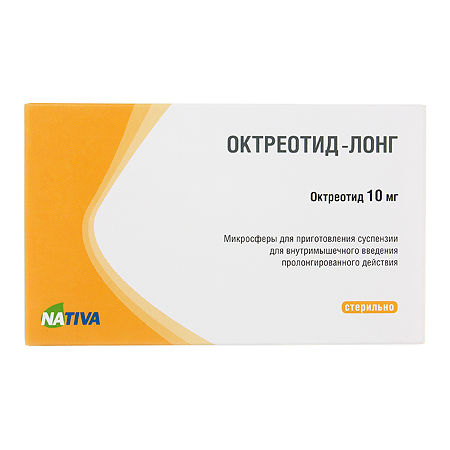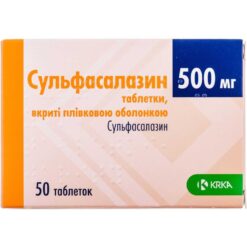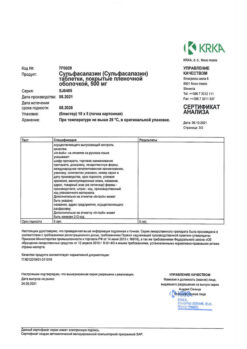No products in the cart.
Octreotide-Long microspheres, 10 mg
€1.00
Out of stock
(E-mail when Stock is available)
Description
Octreotide-long is a dosage form of Octreotide for intramuscular administration, which provides maintenance of stable therapeutic concentrations of Octreotide in blood for 4 weeks.
Octreotide is a synthetic octapeptide, a derivative of the natural hormone somatostatin, which has similar pharmacological effects to it, but much longer duration of action.
Octreotide suppresses pathologically increased secretion of growth hormone (GH) as well as peptides and serotonin produced in the gastro-entero-pancreatic endocrine system.
In healthy individuals, octreotide, like somatostatin, suppresses GH secretion induced by arginine, exercise and insulin hypoglycemia; insulin, glucagon, gastrin and other peptides of the gastro-entero-pancreatic endocrine system secretion induced by food intake, as well as insulin and glucagon secretion stimulated by arginine; thyrotropin secretion induced by thyreoliberin.
The suppressive effect on GH secretion in octreotide, in contrast to somatostatin, is expressed to a much greater extent than on insulin secretion. Administration of octreotide is not accompanied by the phenomenon of hormones hypersecretion by the negative feedback mechanism. In acromegaly patients administration of Octreotide provides in the vast majority of cases persistent decrease of GH level and normalization of insulin-like growth factor 1 (IGF-1) concentration.
In patients with acromegaly, octreotide significantly reduces symptoms such as headache, increased sweating, paresthesias, fatigue, bone and joint pain, peripheral neuropathy. In patients with pituitary adenoma secreting GH leads to a reduction in tumor size.
In carcinoid tumors the use of the drug leads to reduction of the severity of symptoms of the disease, especially such as “hot flashes” and diarrhea. In many cases clinical improvement is accompanied by decrease of plasma serotonin concentration and urinary excretion of 5-hydroxyindoleacetic acid.
In tumors characterized by hyperproduction of vasoactive intestinal peptide (VIP), use of octreotide results in a reduction of the severe secretory diarrhea characteristic of this condition, which in turn improves the patient’s quality of life.
At the same time there is a reduction of concomitant electrolyte balance disorders, such as hypokalemia, which allows to cancel enteral and parenteral administration of fluids and electrolytes. According to computed tomography in patients there is a slowing or stopping the progression of tumor growth, and even a decrease in its size, especially liver metastases. Clinical improvement is usually accompanied by a decrease (down to normal values) in plasma concentration of VIP.
In glucagonomas, use of Octreotide results in a marked reduction of the necrotizing migratory rash that is characteristic of this condition. Octreotide has no significant effect on the severity of diabetes mellitus often seen in glucagonomas and usually does not reduce the need for insulin or oral hypoglycemic medications. In patients suffering from diarrhea, the drug causes its reduction, which is accompanied by an increase in body weight. When using Octreotide there is a rapid decrease of glucagon concentration in plasma, but this effect does not persist with long-term treatment. Symptomatic improvement remains stable for a long time.
In gastrinomas (Zollinger-Ellison syndrome), the drug, used as monotherapy or in combination with H2-histamine receptor blockers and proton pump inhibitors, reduces the formation of hydrochloric acid in the stomach and leads to clinical improvement, including diarrhea. When octreotide is given, there is a reduction in the severity of symptoms associated with peptide synthesis by the tumor, including “hot flashes”.
In some cases there is a decrease of plasma concentration of gastrin. In patients with insulinomas octreotide decreases the content of immunoreactive insulin in blood.
In patients with operable tumors Octreotide can provide restoration and maintenance of normoglycemia in the preoperative period. In patients with inoperable benign and malignant tumors, glycemic control may improve without a simultaneous prolonged decrease in blood insulin concentrations.
In patients with rare tumors hyperproducing growth hormone releasing factor (somatoliberinomas), octreotide reduces acromegaly symptoms, which is associated with suppression of growth hormone releasing factor secretion and GH itself. Thus, subsequently, there is a decrease in the size of the pituitary gland, which was enlarged before the start of treatment.
The pool of neuroendocrine cells expressing somatostatin receptors affinity for octreotide (SS2 and SS5 types) increases in patients with hormone-resistant prostate cancer (GR prostate cancer), which determines tumor sensitivity to octreotide. Application of octreotide in combination with dexamethasone against the background of androgen blockade (medical or surgical castration) in patients with HP RA restores sensitivity to hormonal therapy and leads to reduction of prostatic specific antigen (PSA) in more than 50% of patients.
In patients with GR CRC with bone metastases this therapy is accompanied by a pronounced and long-lasting analgesic effect and improves quality of life.
Indications
Indications
Octreotide is a pathogenetic therapy for tumors actively expressing somatostatin receptors.
In the therapy of acromegaly:
Active ingredient
Active ingredient
Composition
Composition
Octreotide acetate converted to octreotide 10.0 mg
Excipients:
DL-lactic and glycolic acid copolymer 270.0 mg
D-Mannitol 85.0 mg
Sodium Carmellose 30.0 mg
/p>
Polysorbate=80 2.0 mg
The solvent to prepare the suspension is Mannitol, 0.8% solution
Composition per 1 ml:
D-Mannitol 8.0 mg
Injection water up to 1.0 ml
How to take, the dosage
How to take, the dosage
The drug Octreotide-Long should only be injected deeply intramuscularly, into the gluteal muscle.
In repeated injections the left and right sides should be alternated. The suspension should be prepared immediately prior to injection.
On the day of injection, the bottle with the drug and the ampoule with the solvent can be kept at room temperature.
In acromegaly, a 3-day trial with subcutaneous injection of Octreotide (300 mcg/day) is recommended in advance to decide the tolerability and effectiveness of long-term treatment with Octreotide-Long.
A decrease in IGF-1 blood levels greater than 60% of baseline (in the absence of signs of intolerance) would indicate a good prognosis for use of the drug as prolonged primary or secondary pharmacotherapy.
For patients who are less sensitive to the drug, the starting dose should be higher.
For the resistant group of patients, surgical intervention is recommended. In the case of nonradical adenomectomy, a 3-day subcutaneous trial increases sensitivity to subsequent drug therapy.
For patients in whom p/c administration of Octreotide provides adequate control of disease manifestations, the recommended starting dose of Octreotide-Long is 20 mg every 4 weeks for 3 months.
The treatment with Octreotide-Long can be started the day after the last p/c injection of Octreotide solution.
Thereafter, the dose of the drug is adjusted according to the serum concentrations of GH and IGF-1 and clinical symptoms.
If adequate clinical and biochemical effects are not achieved after 3 months of treatment (particularly if the GH concentration remains above 2.5 µg/L), the dose can be increased to 30 mg administered every 4 weeks. In cases where, after 3 months of treatment with Octreotide-Long at a dose of 20 mg, there is a persistent decrease in serum GH concentration below 1 µg/L, normalization of IGF-1 concentration, and disappearance of reversible acromegaly symptoms, the Octreotide-Long dose may be reduced to 10 mg.
But in these patients receiving a relatively low dose of Octreotide-Long, serum GH and IGF-1 concentrations and symptoms should continue to be monitored closely.
Patients receiving a stable dose of the drug should have their GH and IGF-1 concentrations determined every 6 months.
In endocrine tumors of the GI tract and pancreas, for patients in whom p/c administration of Octreotide provides adequate control of disease manifestations, the recommended starting dose of Octreotide-Long is 20 mg every 4 weeks.
The subcutaneous administration of Octreotide should be continued for an additional 2 weeks after the first administration of Octreotide-Long.
For patients who have not previously received octreotide p/c, it is recommended that treatment begin with a p/c dose of 100 mcg of Octreotide 3 times/day for a relatively short period (approximately 2 weeks) in order to evaluate its effectiveness and overall tolerability. Only after that should Octreotide-long be administered according to the above scheme.
If therapy with Octreotide-Long for 3 months provides adequate control of clinical manifestations and biological markers of the disease, it is possible to reduce the dose of Octreotide-Long to 10 mg administered every 4 weeks.
In cases where only partial improvement has been achieved after 3 months of treatment with Octreotide-Long, the dose may be increased to 30 mg every 4 weeks.
On some days during treatment with Octreotide-Long there may be an increase in clinical manifestations characteristic of endocrine tumors of the gastrointestinal tract and pancreas.
In these cases, additional oral administration of Octreotide solution at the dose used prior to treatment with Octreotide-Long is recommended.
This may occur primarily in the first 2 months of treatment until therapeutic plasma concentrations of Octreotide are achieved.
In hormone-resistant prostate cancer, the recommended starting dose of Octreotide-long is 20 mg every 4 weeks for 3 months.
Thereafter, the dose of the drug is adjusted according to the changes in the serum concentration of prostate-specific antigen (PSA) and clinical symptoms.
If after 3 months of treatment failed to achieve adequate clinical and biochemical effect (decrease of PSA), the dose may be increased to 30 mg given every 4 weeks.
The treatment with Octreotide-Long is combined with the use of dexamethasone, which is administered orally according to the following regimen: 4 mg daily for 1 month, then 2 mg daily for 2 weeks, then 1 mg daily (maintenance dose).
The treatment of patients who have previously received medication-assisted antiandrogen therapy is combined with the use of a gonadotropin-releasing hormone (GnRH) analogue.
Injections of a GnRH analogue (a prolonged form) are given once every 4 weeks.
Patients receiving Octreotide-Long should have their PSA concentrations determined every month.
In patients with impaired renal function, hepatic function and in elderly patients there is no need to adjust the dosing regimen of Octreotide-Long.
Interaction
Interaction
Octreotide decreases intestinal absorption of cyclosporine and slows down absorption of cimetidine.
The bioavailability of Octreotide and bromocriptine is increased with concomitant use.
There is literature evidence that somatostatin analogues may decrease the metabolic clearance of substances metabolized by cytochrome P450 enzymes, which may be caused by GH suppression.
Because these effects of octreotide cannot be excluded, drugs that are metabolized by cytochrome P450 enzymes and have a narrow therapeutic dose range (such as quinidine and terfenadine) should be prescribed with caution.
Special Instructions
Special Instructions
In pituitary tumors secreting GH, patients must be monitored closely because tumors can enlarge with serious complications such as narrowing of the visual fields.
In these cases other treatment options should be considered. In 15-30% of patients who receive octreotide p/k for a long time, gallstones may appear in the gallbladder. The prevalence in the general population (age 40-60 years) is 5-20%.
The experience of long-term treatment with prolonged-acting octreotide in patients with acromegaly, with GI and pancreatic neuroendocrine tumors indicates that prolonged-acting octreotide compared with short-acting octreotide does not result in an increased incidence of gallstones.
Yet, an ultrasound of the gallbladder is recommended before starting treatment with Octreotide-long FS and approximately every 6 months during treatment.
The gallstones in the gallbladder, if detected, are usually asymptomatic. In patients with type 1 diabetes, Octreotide-long FS may affect glucose metabolism and therefore reduce the need for insulin administration.
For patients with type 2 diabetes mellitus and patients without a concomitant carbohydrate metabolism disorder, subcutaneous injections of Octreotide may result in postprandial glycemia. In this connection it is recommended to monitor blood glucose concentration regularly and to correct hypoglycemic therapy if necessary.
In patients with insulinomas during treatment with Octreotide an increase in severity and duration of hypoglycemia may be noted (this is due to a more pronounced suppressive effect on GH and glucagon secretion than on insulin secretion, as well as a shorter duration of inhibitory effect on insulin secretion). Systematic follow-up of these patients is indicated.
In some patients octreotide may alter intestinal fat absorption. Decreased cyanocobalamin (vitamin B12) and abnormal cyanocobalamin absorption test values (Schilling test) have been noted with Octreotide.
In patients with a history of vitamin B12 deficiency when using Octreotide, it is recommended to monitor cyanocobalamin levels.
Patients should have an ultrasound of the gallbladder before prescribing Octreotide. During treatment with Octreotide-long FS, repeated ultrasounds of the gallbladder should be performed, preferably at intervals of 6-12 months.
If gallstones are detected before starting treatment, the potential benefits of Octreotide-Long FS therapy should be evaluated against the possible risks associated with the presence of gallstones. There is currently no evidence that prolonged-acting Octreotide adversely affects the course or prognosis of pre-existing gallstone disease.
Management of patients with gallstones that form during treatment with Octreotide-Long FS
(a) Asymptomatic gallstones.
The use of Octreotide-long FS can be discontinued or continued according to a benefit/risk assessment. In either case, no other measures are required except to continue examinations, making them more frequent, if necessary.
b) Gallbladder stones with clinical symptoms.
The use of Octreotide-Long FS may be discontinued or continued according to a benefit/risk assessment. In either case, the patient should be treated as in other cases of cholelithiasis with clinical manifestations.
Application in children
There is limited experience with use in children
Impact on ability to drive and operate machinery:To date, there are no data on the effect of octreotide on ability to drive and operate machinery.
Contraindications
Contraindications
Hypersensitivity to octreotide or other components of the drug.
With caution:cholelithiasis, diabetes mellitus.
Side effects
Side effects
Evaluation criteria for the incidence of adverse reactions: very common (>1/10); common (â¥1/100, <1/10); sometimes (â¥1/1000, <1/100); rare (â¥1/10000, <1/1000); very rare (<1/10000), including individual reports.
Local reactions: often pain, less often swelling and rash at the injection site (usually mild, short-lived) may occur when administered by injection.
The digestive system: often – spastic abdominal pain, abdominal distension, excessive gas, loose stool, diarrhea; sometimes – cholecystitis; rarely – nausea, vomiting, gallstone formation in the gallbladder, steatorrhea. Although excretion of fat with feces may increase, there are no indications that long-term treatment with Octreotide may lead to impaired absorption (malabsorption). In rare cases – phenomena resembling acute intestinal obstruction: progressive abdominal bloating, pronounced pain in the epigastric region, abdominal wall tension. Rare cases of acute pancreatitis developed during the first hours or days of p/c use of Octreotide have been reported. Cases of pancreatitis associated with cholelithiasis have been reported with long-term use.
There have been isolated reports of liver function abnormalities (acute hepatitis without cholestasis with normalization of transaminases after discontinuation of Octreotide); slow development of hyperbilirubinemia accompanied by elevated alkaline phosphatase, gamma-glutamyltransferase values.
Endocrine system disorders: in rare cases persistent hyperglycemia and hypoglycemia may develop.
Cardiovascular system disorders: sometimes – bradycardia, tachycardia.
Respiratory system disorders: very rarely – shortness of breath.
Allergic reactions: rare – hypersensitivity, rash; very rare – anaphylaxis.
Others: in rare cases, temporary hair loss has been reported after administration of octreotide.
Overdose
Overdose
No adverse events have been reported in patients with malignancies when octreotide is administered at a dose of 90 mg every 2 weeks.
In a single 1-mg dose of octreotide by IV bolus in an adult patient, symptoms such as transient bradycardia, blood flushes to the face, spastic abdominal pain, diarrhea, a feeling of emptiness in the stomach, and nausea have been described. All described symptoms resolved within 24 hours of drug administration.
Treatment:symptomatic.
Similarities
Similarities
Additional information
| Manufacturer | Nativa, Russia |
|---|---|
| Medication form | suspension for injection |
| Brand | Nativa |
Related products
Buy Octreotide-Long microspheres, 10 mg with delivery to USA, UK, Europe and over 120 other countries.










